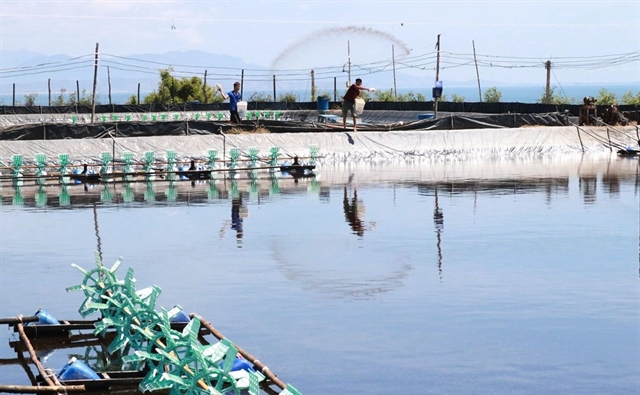 Economy
Economy


|
| A shrimp raising pond in the southern province of Ninh Thuận. Farmers are encouraged to begin raising shrimp right now to catch up with opportunities after COVID-19 pandemic. — VNA/VNS Photo Nguyễn Thành |
HÀ NỘI — Việt Nam’s pushback of the COVID-19 pandemic has helped shrimp exporters raise their competitiveness on the world market, overtaking competitors such as India and Ecuador, which are still struggling with the outbreak and not yet able to return to normal production.
The statement was released by the Vietnam Association of Seafood Exporters and Producers (VASEP) in Hà Nội on Tuesday.
According to VASEP, the April shrimp export increased by 5.8 per cent to US$242.2 million, marking total $872.8 million in the first four months of this year, up 2.9 per cent year-on-year.
General Secretary of VASEP Trương Đình Hòe said the prices of shrimp in April, including raw materials, is more positive than in previous months. Inventory in big markets is not much.
“Demand for shrimp decreased in restaurants and hotels but increased in supermarkets and retail systems thanks to the trend of home processing during the COVID-19 pandemic,” Hòe said.
Japan remained the largest shrimp import market of Việt Nam, accounting for 20.7 per cent of the country’s the total export value. After a slight decrease in March, the export to Japan increased by 19 per cent to $48.6 million in April, making total January-April export value of $180.5 million, up 11 per cent compared to the same period last year.
It’s followed by the US with a turnover of $158.7 million in shrimp products from Việt Nam in the first four months of this year, an increase of 17 per cent over the same period last year.
Meanwhile, the January-April export value to EU decreased by nearly 8 per cent, reaching $123 million.
With the EU market, Hòe said Việt Nam has a favourable advantage from the Europe-Vietnam Free Trade Agreement, which is currently being discussed by Việt Nam’s National Assembly and is expected to come into effect in July.
“However, potential risks still exist, so processors, exporters and shrimp raisers need to work closely to remove difficulties and seize opportunities when the market recovers,” Hòe said.
China increased shrimp imports from Việt Nam for the first time after a continuous decline in the previous three months. In April, Việt Nam’s shrimp exports to China reached $39.2 million, up 16.6 per cent year-on-year. The total exports to China in the first four months of this year reached $108.8 million, down 15.5 per cent year-on-year.
VASEP said that China's demand for shrimp imports in the second quarter of this year is expected to recover as the country has gradually curbed the COVID-19 pandemic. Many Chinese shrimp enterprises have returned to production while the domestic supply of Chinese shrimp is limited due to disease in farmed shrimp.
EVFTA opportunities
Insiders said that the Việt Nam’s export of shrimp has many opportunities when key shrimp exporters including India, Ecuador and Thailand have been delayed by the national blockade. The orders of shrimp are expected to shift to Việt Nam.
The upcoming EVFTA will help Vietnamese shrimp industry to compete better in Europe, along with low shrimp export tax to the US market, Việt Nam’s shrimp export is expected to continue increasing in the coming months.
However, the domestic shrimp industry is dealing with negative impacts from disease, drought and saline intrusion, which is hindering farmers to develop shrimp breeding.
VASEP recommended farmers to raise shrimp in order to catch up with the opportunities after COVID-19. If the pandemic is completely controlled, the market will restore and the price of shrimp will recover as well.
VASEP said that consumers would switch to using smaller and medium sized shrimp due to falling incomes. “In the context of the COVID-19 pandemic, large-sized shrimp consumption channels, such as restaurants and hotels, were closed, resulting in reduced demand.”
To develop shrimp breeding area, Hòe said VASEP has proposed the Ministry of Agriculture and Rural Development to create favourable conditions for shrimp raisers and fishermen in order to help businesses promote exports to the world market. — VNS




